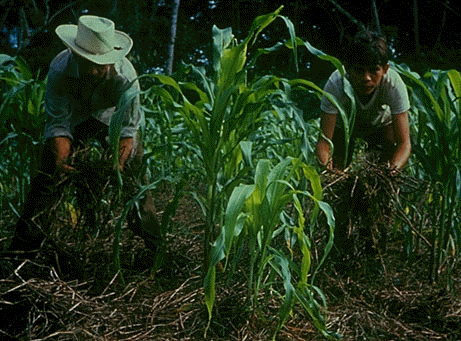

Slash/Mulch Systems - Velvetbean (Mucuna) Maize System
One of the first reports found in the literature on the use of velvetbeans (Mucuna spp.) in a slash/mulch system in Central America was by William E. Carter in 1969 describing the use of velvetbeans as a mulch in the lowlands of Guatemala by Kekchi Indians, a Maya group that had migrated from the highlands of Guatemala.
 |
 |
| Maize growing through mucuna mulch (mulch being shown by farmers) (Picture courtesy of Roland Bunch) | Planting maize in slashed mucuna mulch with dibble stick (Courtesy Milton Flores - CIDICCO) |
| Although most agriculture in this lowland region used the slash-and-burn system for their maize plantings (milpas), in the dry season fields were often planted to velvetbeans. Carter wrote that the technique was to dibble a shallow hole and drop seeds three at a time into it, spacing the hillocks some 4 varas (83.5 cm) apart. After two months of growth, velvet beans began to have drastic effects on the milpa. Where weeds, grasses, and small trees have begun to take hold, it gradually covers them and chokes them out. Within six months, mucuna yields a thick cover of dark green leaves that can reach up to 8 feet in height. Once the luxurious growth of the velvetbeans reached a height of 2.5 meters the Kekchi slashed the growth with machetes and chopped it up finely. The result was a mulch 8-10 cm thick of the decayed velvetbean vegetation on the soil. Carter claimed that plots planted to velvetbean did not revert to grassland or forest, and that some plots had been used consecutively for 14 years of dry season farming with little indication of diminishing fertility. These observations were an early indication of the possibility of sustaining soil fertility in the lowland tropics with the velvetbean or other cover crop systems for long periods of time with a minimum of inputs. | |
| Mucuna growing over mature maize (Courtesy Milton Flores - CIDICCO) | |
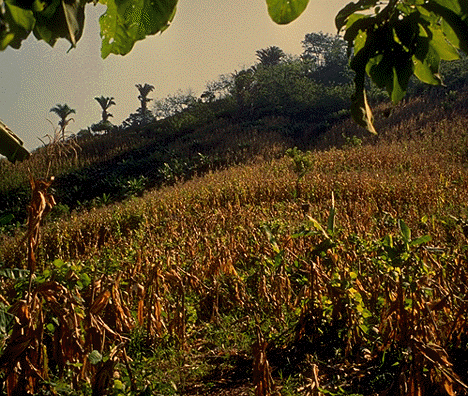 |
Maize growing through mucuna mulch (Courtesy Milton Flores - CIDICCO) |
| Regarding the system in Honduras Milton Flores of
CIDICCO
wrote: "Farmers using velvetbean for the first time, plant the legume
1-2 months after planting corn, at the beginning of January. Later on, when
corn is harvested, its stalks are bent over and left on the fields. Velvetbean
starts covering these stalks and soon the legume will take over the whole
corn field. By December the large amounts of velvetbean foliage (varying
from 50-70 mt/ha) begin to dry out until it finally ends on top of the ground
providing a cover that can be up to 20 cm thick. This means that the next
corn crop is planted directly through the mulch. The mulch suppresses weeds
and allows an adequate establishment of the corn. During the second year,
velvetbean seeds will volunteer from last year and the cycle continues with
the planting of a new corn.
|
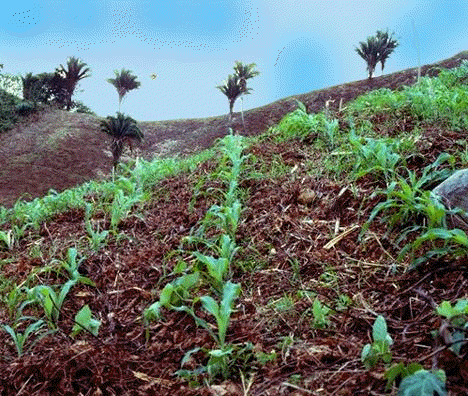 |
| Even without chemical fertilizers, maize yields of 2-4 tons
per hectare were obtained using the above system, more than double the national
average yields for Honduras. Hillside erosion was also reduced in the region.
By adopting the velvetbean system, rather than plowing fields, farmers have
essentially changed to a more sustainable no-till system.
CIDICCO indicated that velvetbean foliage was often slashed to plant a second crop of maize, and then incorporated or left as a mulch. Although incorporation would clearly reduce loss of nitrogen due to volatilization, peasant farmers in Honduras, primarily because of the high labor requirements of incorporation, preferred to mulch. Where farmers have access to tractors or animal traction and labor costs are low, incorporation might be advantageous, although benefits would obviously vary according to soil and climatic conditions and tillage would seldom be selected on very steep slopes.
|
More pictures on mucuna (click on the picture for a larger image) :
*Some of the pictures below were prepared by Christine Stockwell or Lucy Fisher.
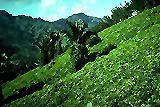 Steep
hillside planted to mucuna in Honduras (Picture courtesy Bernard Triomphe)
Steep
hillside planted to mucuna in Honduras (Picture courtesy Bernard Triomphe)
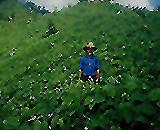 Field
of mucuna (Courtesy Milton Flores - CIDICCO)
Field
of mucuna (Courtesy Milton Flores - CIDICCO)
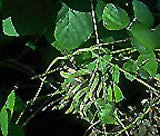 Immature
mucuna pods (Courtesy Milton Flores - CIDICCO)
Immature
mucuna pods (Courtesy Milton Flores - CIDICCO)
 Three
colors of mucuna seeds (Courtesy Milton Flores - CIDICCO)
Three
colors of mucuna seeds (Courtesy Milton Flores - CIDICCO)
 Organic
matter produced by mucuna (Courtesy Milton Flores - CIDICCO)
Organic
matter produced by mucuna (Courtesy Milton Flores - CIDICCO)
More traditional agricultural methods :
| Mulching |
| Slash/Mulch | Frijol Tapado / Web Blight |
| Manipulating Shade | Burning | Flooding |
| Multiple Cropping | Using Organic Amendments |
| Rotations | Fallow | Raised Beds |